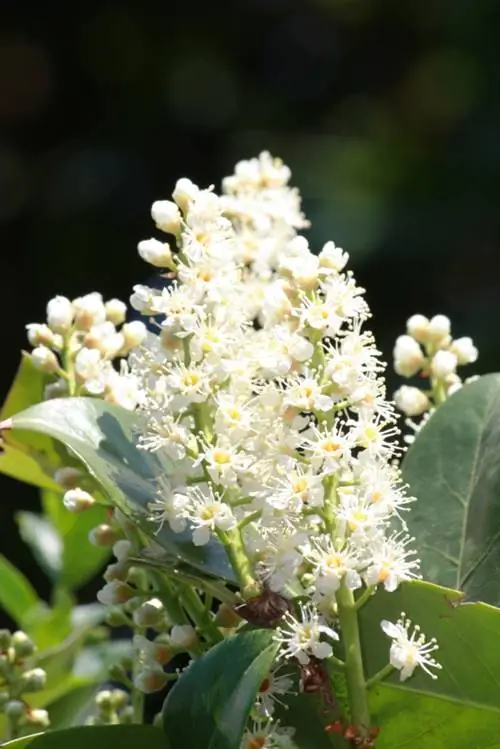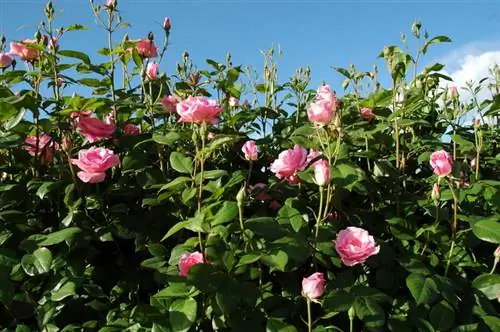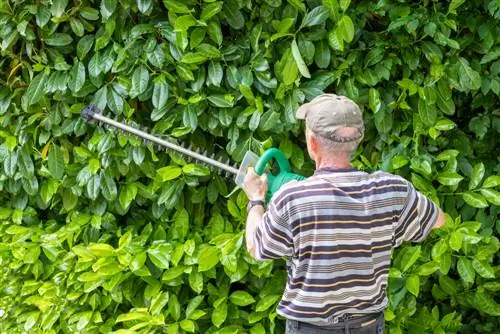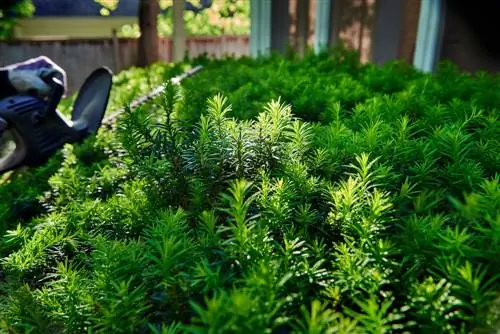- Author admin [email protected].
- Public 2023-12-16 16:46.
- Last modified 2025-01-23 11:20.
Garden owners with children in particular often look for cherry laurel species that hardly produce any fruit due to the toxicity of the berries. Although there is no type of laurel cherry that does not bloom or set any berries, you can take a few measures to limit the bush's fruit set or even prevent fruit formation entirely.

Which types of cherry laurel hardly produce fruit and how do I prevent fruit formation?
To get cherry laurel without berries, choose varieties such as Rotundfolia or Genolia, which flower and produce fewer fruits. Cut back the spent inflorescences immediately after flowering to prevent fruit setting and to allow the plant to grow more densely.
Choice of varieties
There are Prunus species that bloom only weakly and therefore only produce a few fruits. These include the varieties Rotundfolia and Genolia. However, the large-leaved species Rotundfolia is not as frost-hardy as other cherry laurels. Therefore, in rough areas, always give the tree adequate winter protection so that the laurel cherry does not freeze back too much. Genolia is characterized by its slender growth, which is why this variety is often referred to as columnar cherry laurel. It is extremely hardy and is also suitable for small gardens and narrow hedges.
Cutting back the spent inflorescences
If you want to prevent fruit setting, you should cut out all withered parts of the plant immediately after flowering. Some species bloom a second time a year and then need to be pruned again. Thanks to this care measure, the cherry laurel remains without fruit and the plant also grows more densely because it puts all its strength into the new shoots.
A strong pruning in late summer almost completely prevents flowers from forming in spring. However, you should not cut back the cherry laurel too late in the year so that the tree survives the winter well. Depending on the region, the latest cutting time is the end of August to mid-September.
The cherry laurel doesn't bloom unintentionally
Cherry laurel has hermaphroditic flowers, which means that there are both male and female flower parts in one inflorescence. Unlike many trees in which the male plants do not bear any flower decorations, all cherry laurels bloom and are therefore not left without fruit.
For some species it can take several years until the first inflorescences appear. If an older laurel cherry does not bloom, the cause is usually poor soil conditions. Bay cherries love humus-rich and well-drained soil with a high nutrient content. Improve heavy clay soils with mature compost and loosen the subsoil with coarse-grained sand.
Tips & Tricks
Ground cover cherry laurel like the Mount Verno variety only grows to about half a meter high and naturally produces almost no flowers or fruits at all.






